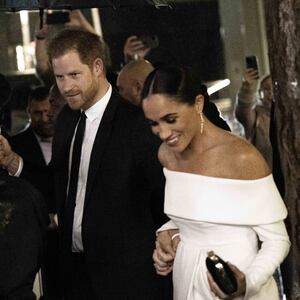“They are like two high schoolers in love,” my flatmate says, half an hour into the first episode of Harry & Meghan, Netflix’s six-part docuseries on the royal couple that premiered on Dec. 8. The streaming giant cheekily dubbed the launch as a “global event,” and, for all those who mocked its gall, perhaps it’s telling that mere minutes after the series released, Netflix reportedly crashed (?!) from too much traffic.
Since the first trailer dropped on Dec. 1, both royal enthusiasts and skeptics awaited the series release with bated breath, hoping that the loose-lipped couple would drop more truth bombs about the mysterious institution that is the royal family. Well, sorry to disappoint but Part 1, containing the first three episodes, reveals little in the name of damning secrets about “the firm.” Instead, as my flatmate rightly describes it, the series shows two people so disgustingly in love that it puts Nicholas Sparks to shame. He jokes, she laughs; she teases and he plays along with a shy smile. They are so saccharine it hurts to not be cuffed with your own romance while watching them.
Sure the words are sweet, but what captured their relationship best and kept me hooked for three long hours is the medium that Harry and Meghan choose to tell their story. By recording videos on their iPhones like so many of us do, it creates a sense of intimacy that matters more than the (not always juicy) content. It creeps up on you slowly, making you empathize before you realize it. Episode 1 opens with a frazzled Harry talking to his front-facing camera. The first voice we hear in the series is his deep and pained sigh. The captions reveal that the clip is from March 2020 and was filmed at the Windsor Suite of London’s Heathrow Airport. As the portrait mode video fills the screen, Harry says, “Hi, so we’re here on er, Tues…Wednesday, the something of March. Um, we’ve just finished, um, two weeks, our final push, our last stint of royal engagements.”
The tension is palpable. Watching Eton-educated Harry, who has been addressing the public since he was a teen, stuttering and stammering in front of the phone camera, unable to sit still, reveals more about the situation that the couple was embroiled in than any big-name feature or interview ever did. “It’s really hard to look back on it now and go, what on Earth really happened, like, how did we end up here,” he continues, as a black-and-white montage of the couple through the years plays in the background.
Later in the series, Harry explains that his and Meghan’s friends suggested that they film the transition of stepping down as working royals and moving to the U.S. These real-time, self-filmed videos form the most vulnerable and meatiest bulk of Part 1 of the docuseries. The first time we hear from Meghan, it is once again through what I call the 2022 version of a home video. Crouched on what appears to be her bedroom floor in Vancouver, the Duchess of Sussex says, “H is in London while I’m here. I don’t even know where to begin.” Sans any makeup, dressed in a button-down navy shirt with blue denims and a towel wrapped around her damp hair, this is the rawest and most intimate visual we have seen of Meghan since she married into royalty.
“I just want to get to the other side of all of this,” she says, her voice teetering as we see her struggle to hold back tears. As heartbreaking as it all is, I can’t help but compare this portrayal to the stream of TikTok videos that members of Gen Z make, baring their souls to the camera as tears stream down their faces. The absence of any conscious curation and the candidness with which Harry and Meghan film these little clips evoke the mood of Emma Chamberlain's weekly vlogs from her early YouTube days. The haughtiness and celebrity of the royal titles disappear for a bit and Harry and Meghan appear to be a regular (albeit privileged) couple waiting to build a life together. While the series features interviews with Harry's boarding school mates, Meghan’s mother, and several experts, most conversations just feed into this narrative of “normalness.”
For years, every little movement the couple made has been recorded and packaged for public critique, othering them as the royals who didn't care enough about the establishment to stick around. But since their resignation, Harry and Meghan have been relentlessly clutching at straws, hoping to take control of the narrative. And so, we have the Holy Trinity: It began with the bombshell tell-all interview with Oprah Winfrey, a royal interview so shocking it may be second in drama only to Diana's controversial Panorama conversation. In the middle, there’s the Netflix docuseries hoping to make the couple relatable with their holiday selfies and their Soho date nights. And finally, in January we get Spare, Harry's hotly anticipated memoir whose title alone stirred chaos in the media for days.
In the first episode, Meghan takes a video of Harry driving a convertible. She slowly places her hand on his as they giggle—the classic “we are in love” post that spams Instagram. Suddenly it feels like I'm swiping through my friends’ stories and not watching a video of Prince Harry, son of King Charles and formerly third in line to the British throne. This comfort and easy access to a couple that has always seemed too aspirational, too untouchable for the common eye is precisely what these videos hope to achieve.

Prince Harry and Meghan, The Duke and Duchess of Sussex.
Courtesy of Prince Harry and Meghan/NetflixIn the docuseries, Harry and Meghan reject the “us vs. them” trope that the royal family has always maintained from the public by promising intimacy. The series avoids professional drone shots and instead features funny-face photo booth pictures of the couple. It shows videos of Harry playing with swans to make Meghan laugh instead of stiff but extravagant portraits. This is a refreshing break from the norm. When the royal family is faced with jarring questions, their slow, diplomacy-clad response always arrives through royal correspondents and representatives: “No comment.”
Harry and Meghan turn this strategy on its head with their consistent dialogue, emphasizing that they understand that times are different—and our culture is different. For every viewer who finds the royal couple relatable because they found each other on Instagram, or because Meghan uses Snapchat's popular dog filter, or because they film journal-like videos, there is a PR team celebrating. In the documentary, they cleverly create a binary between traditional media—that is consumed by the older generation that worships the symbol of the royal family—and modern media that highlights the audience they are targeting: millennials and Gen Z, who enjoy authenticity and obsess over consent and control.
As per their narrative, tabloids and old-school media equal an invasion of privacy. In fact, Harry even breaks down how the royal media rota works in an episode, calling it an “extended PR arm” of the family. In place of them, Spotify, Netflix, and Instagram become the couple’s means of communication—remember when Harry and Meghan broke the news of their move to the U.S. in an Instagram post?
With every detail the docuseries bares—from Harry using tea-light candles as decor while proposing to Meghan to the couple sneaking onto a private beach for a swim in California or their friends revealing just how smitten they are—it is making a larger point. It underscores the love, intimacy and, more than anything, the normalcy that prevails within their family of four—so unroyal and, if I may, far from what we see of the press tour photos from Will and Kate’s vacations. The message is received loud and clear: You are more like us than you ever were like them.








